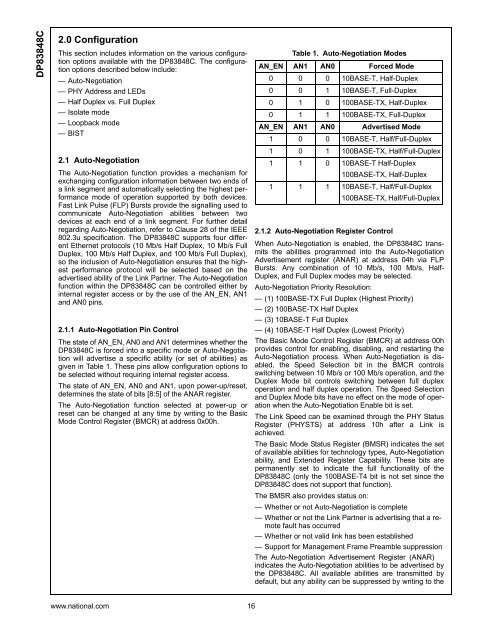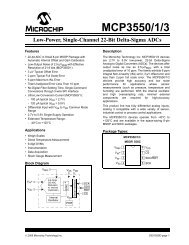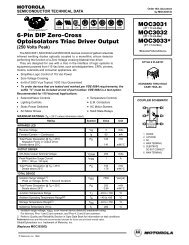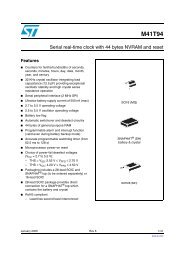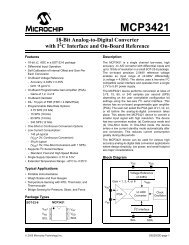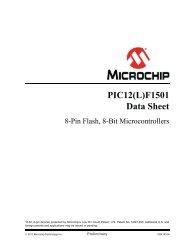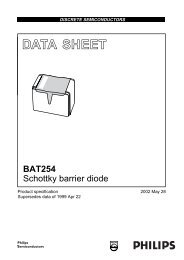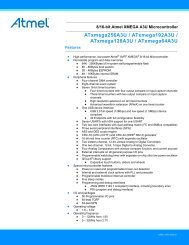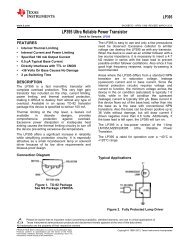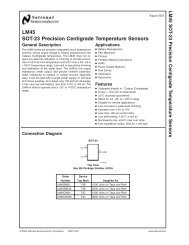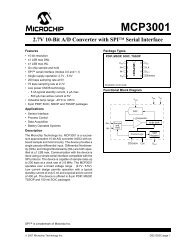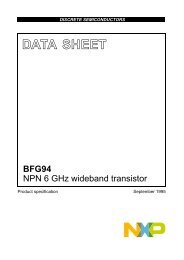DP83848C PHYTER Comm Temp Single Port ... - Texas Instruments
DP83848C PHYTER Comm Temp Single Port ... - Texas Instruments
DP83848C PHYTER Comm Temp Single Port ... - Texas Instruments
You also want an ePaper? Increase the reach of your titles
YUMPU automatically turns print PDFs into web optimized ePapers that Google loves.
<strong>DP83848C</strong>2.0 ConfigurationThis section includes information on the various configurationoptions available with the <strong>DP83848C</strong>. The configurationoptions described below include:— Auto-Negotiation— PHY Address and LEDs— Half Duplex vs. Full Duplex— Isolate mode— Loopback mode—BIST2.1 Auto-NegotiationThe Auto-Negotiation function provides a mechanism forexchanging configuration information between two ends ofa link segment and automatically selecting the highest performancemode of operation supported by both devices.Fast Link Pulse (FLP) Bursts provide the signalling used tocommunicate Auto-Negotiation abilities between twodevices at each end of a link segment. For further detailregarding Auto-Negotiation, refer to Clause 28 of the IEEE802.3u specification. The <strong>DP83848C</strong> supports four differentEthernet protocols (10 Mb/s Half Duplex, 10 Mb/s FullDuplex, 100 Mb/s Half Duplex, and 100 Mb/s Full Duplex),so the inclusion of Auto-Negotiation ensures that the highestperformance protocol will be selected based on theadvertised ability of the Link Partner. The Auto-Negotiationfunction within the <strong>DP83848C</strong> can be controlled either byinternal register access or by the use of the AN_EN, AN1and AN0 pins.2.1.1 Auto-Negotiation Pin ControlThe state of AN_EN, AN0 and AN1 determines whether the<strong>DP83848C</strong> is forced into a specific mode or Auto-Negotiationwill advertise a specific ability (or set of abilities) asgiven in Table 1. These pins allow configuration options tobe selected without requiring internal register access.The state of AN_EN, AN0 and AN1, upon power-up/reset,determines the state of bits [8:5] of the ANAR register.The Auto-Negotiation function selected at power-up orreset can be changed at any time by writing to the BasicMode Control Register (BMCR) at address 0x00h.Table 1. Auto-Negotiation ModesAN_EN AN1 AN0 Forced Mode0 0 0 10BASE-T, Half-Duplex0 0 1 10BASE-T, Full-Duplex0 1 0 100BASE-TX, Half-Duplex0 1 1 100BASE-TX, Full-DuplexAN_EN AN1 AN0 Advertised Mode1 0 0 10BASE-T, Half/Full-Duplex1 0 1 100BASE-TX, Half/Full-Duplex1 1 0 10BASE-T Half-Duplex100BASE-TX, Half-Duplex1 1 1 10BASE-T, Half/Full-Duplex100BASE-TX, Half/Full-Duplex2.1.2 Auto-Negotiation Register ControlWhen Auto-Negotiation is enabled, the <strong>DP83848C</strong> transmitsthe abilities programmed into the Auto-NegotiationAdvertisement register (ANAR) at address 04h via FLPBursts. Any combination of 10 Mb/s, 100 Mb/s, Half-Duplex, and Full Duplex modes may be selected.Auto-Negotiation Priority Resolution:— (1) 100BASE-TX Full Duplex (Highest Priority)— (2) 100BASE-TX Half Duplex— (3) 10BASE-T Full Duplex— (4) 10BASE-T Half Duplex (Lowest Priority)The Basic Mode Control Register (BMCR) at address 00hprovides control for enabling, disabling, and restarting theAuto-Negotiation process. When Auto-Negotiation is disabled,the Speed Selection bit in the BMCR controlsswitching between 10 Mb/s or 100 Mb/s operation, and theDuplex Mode bit controls switching between full duplexoperation and half duplex operation. The Speed Selectionand Duplex Mode bits have no effect on the mode of operationwhen the Auto-Negotiation Enable bit is set.The Link Speed can be examined through the PHY StatusRegister (PHYSTS) at address 10h after a Link isachieved.The Basic Mode Status Register (BMSR) indicates the setof available abilities for technology types, Auto-Negotiationability, and Extended Register Capability. These bits arepermanently set to indicate the full functionality of the<strong>DP83848C</strong> (only the 100BASE-T4 bit is not set since the<strong>DP83848C</strong> does not support that function).The BMSR also provides status on:— Whether or not Auto-Negotiation is complete— Whether or not the Link Partner is advertising that a remotefault has occurred— Whether or not valid link has been established— Support for Management Frame Preamble suppressionThe Auto-Negotiation Advertisement Register (ANAR)indicates the Auto-Negotiation abilities to be advertised bythe <strong>DP83848C</strong>. All available abilities are transmitted bydefault, but any ability can be suppressed by writing to thewww.national.com 16


